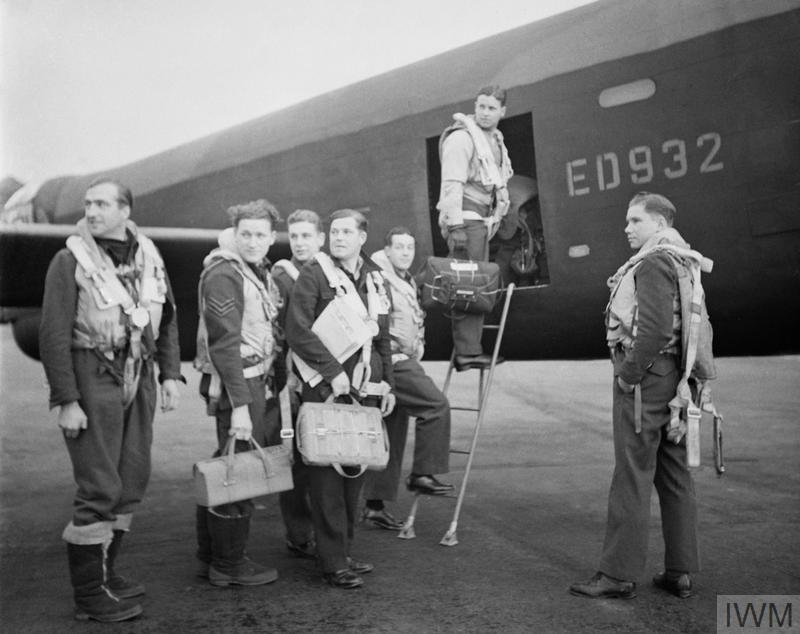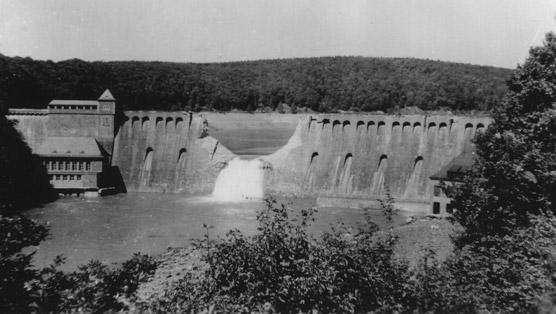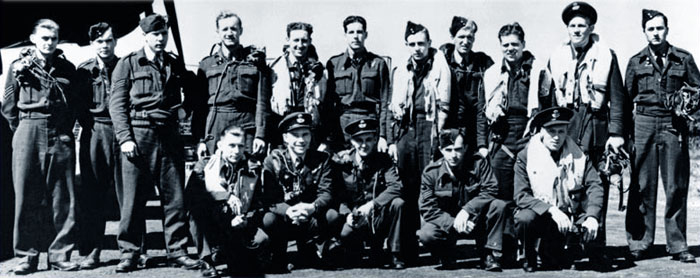Estimated reading time 14 minutes, 33 seconds.
2018 marks the 75th anniversary of Operation Chastise, the legendary Dambusters Raid, which occurred on the night of 16/17 May, 1943.

Seventy-five years ago, 19 Avro Lancaster bombers, with British, Canadian, Australian and New Zealand crews, departed from England on a daring nighttime bombing mission code named “Operation Chastise.”
Their goal was to strike river dams, with the result of disrupting water supplies and industrial production and diverting resources from other aspects of the German war effort.
Challenge
Their actions would test the new parameters for success being demanded of Bomber Command; the invention of one man; and the skills of a squadron of hand-picked veteran crews. Their combined actions resulted in one of the most famous Allied air offenses of the Second World War.
Sir Arthur Harris, commander of Bomber Command, had been given latitude to expand the scope of bomber attacks, but more importantly to ensure the success of bombs reaching the targets–something which had been identified as a problem in the previous years of the war.
His new strategy would involve joint attacks with American bombers against German industrial targets, including oil refineries, shipyards for U-boats, and manufacturing facilities for both aircraft and various forms of transportation.
“[T]he Ruhr remained a principle objective because it was the most important industrial area in the whole of Germany, which was why it had been originally chose for morale-breaking attacks,” Harris noted in his post-war memoir “Bomber Offensive.”
Flooding the valley was identified as a potential solution. But how? The dams of the Ruhr valley were quite solid; the Möhne dam alone was 33 metres thick at the base. The answer lay in an innovative but complicated weapon.

Barnes Wallis, a scientist for Vickers-Armstrong, had come up with the concept of a bomb which, when dropped whilst spinning, would produce the physical effect of impacting against the dam at a point below the water line–thus allowing the dam to be breached.
The trick was to find the right height and speed from which to drop the special bomb. Additionally, the Lancasters had to be modified in order to carry the weighty munition. Unfortunately, this meant removing much of the armour meant to protect it against enemy fire!
On the other hand, thankfully, there was little challenge in finding the right people to fly the Lancasters. For that, Air Chief Marshal Harris entrusted the formation of the squadron–the Royal Air Force’s 617 Squadron–to two-tour veteran Wing Commander Guy Gibson, who already had received the Distinguished Service Order and Bar, and the Distinguished Flying Cross and Bar.
Preparation
Twenty-one crews assembled in Scampton, England to prepare. Given the individual and cumulative experience of the crews, their new training was specialized and focused on the mission at hand.
The focus was on low-level flying at specific speeds–something that was tricky enough to do over the tranquil English countryside, never mind over enemy territory where attack by anti-aircraft artillery or enemy aircraft was very likely!
Details given to the crews were sparse, in order to ensure absolute secrecy, although speculation was rampant. It was thought that perhaps the intended targets would be battleships–the Scharnhorst and Gneisenau, or perhaps even the mighty Tirpitz. Very few, if any, suspected the targets would be the river dams in the Ruhr industrial valley.
By the time the mission was ready to start in May 1943, 19 crews were set to participate in the raids. Each Avro Lancaster had a crew of seven: pilot, navigator, flight engineer, front and rear gunner, bomb aimer, and wireless operator.
Of the total of 133 crew members who flew on May 16, 30 were members of the Royal Canadian Air Force.
Attack
The Lancasters proceeded in three waves–the first wave of nine, a second wave of five, and a third reserve wave of five.

The first wave, commanded by Wing Commander Gibson, led the attacks on the Möhne and Eder Dams. The second wave, under the command of Flight Lieutenant Joseph Charles McCarthy of the RCAF, headed for the Sorpe Dam.
The reserve flight of five would head for the Sorpe Dam, or in the event it was breached, divert towards the Ennerpe or Bever Dam.
At least, that was the plan. But fate had other ideas. Flight Lieutenant McCarthy had to swap his plane due to mechanical issues and lagged behind his wave.
Two aircraft had to abort the mission during the opening leg of the mission. In the end, only 17 travelled to the Ruhr along three different flight paths.
This was to ensure the Luftwaffe was not alerted to the presence of the entire Squadron, so that at least some of the bombers would be able to get through to the intended target region.
Upon reaching the intended target, Wing Commander Gibson’s aircraft, marked “G – George,” made the first dive, levelling off at 20 metres above the Möhne River at a cruising speed of 384 kilometres per hour.
His bomb detonated but did not breach the dam. The next four aircraft followed suit, with Wing Commander Gibson flying alongside to help divert enemy anti-aircraft fire.

The bomb from the fifth Lancaster finally achieved the intended result, and the dam broke open and unleashed its deluge into the valley below. Wing Commander Gibson turned with the remaining three aircraft in his flight towards the Eder Dam, and following the same method, had similar success.
The Möhne and Eder dams were both breached with the surrounding areas flooded. An estimated 1,600 civilians were killed in the flooding.
The Sorpe and Ennerpe dams were damaged but not enough for the waters to break through. German assets were diverted to the region to aid in the clean-up and restoration of services.
In the eyes of the Bomber Command, the mission was a success, even at the high price of 40 per cent casualties. Five aircraft crashed or were shot down on their way to the valley.
Two were destroyed while attacking the dams, and one was shot down on the return flight. In total eight aircraft and 56 crew were lost on the raid.
Casualties aside, Barnes Wallis’s bombs proved successful, and the men of 617 Squadron showcased their capabilities. Wing Commander Gibson was recognized for his leadership and abilities with the Victoria Cross. Of the other 33 who were decorated for their contributions to the raid, seven were members of the Royal Canadian Air Force.
Canadians
Pilot Officers George Deering and Harlo Taerum were the front gunner and navigator on Wing Commander Guy Gibson’s “George” Lancaster, which led the attack; both men were awarded the Distinguished Flying Cross.

Pilot Officer, George Andrew Deering, RCAF, front gunner; Pilot Officer Frederick Spafford, RAAF, Flight Lieutenant Robert Hutchinson, RAF, wireless operator, Flight Sergeant Andrew Deering, RAF, front gunner; and Pilot Officer Harlo “Terry” Taerum, RCAF, navigator. RAF Air Historical Branch Photo
Flight Lieutenant Joseph Charles McCarthy, the captain on board “Tommy” aircraft, received the Distinguished Service Order.
“Orange” navigator Flying Officer Daniel Walker received the bar to his Distinguished Flying Cross, while fellow crew member bomb aimer Sergeant Stefan Oancia received the Distinguish Flying Medal.
The navigator on board “Tommy,” Flight Sergeant Donald MacLean, also received the DFM. Flight Sergeant Kenneth Brown, the captain of “Freddy” was awarded the Conspicuous Gallantry Medal (Flying).
Flying Officer Walker and Pilot Officer Deering were killed just four months later in a bombing raid on Dortmund-Ems canal. The other five Canadian recipients survived the war.
Effect
The May 1943 Dambusters raids had a tremendous impact on morale, both at home and in Germany. Earlier that spring, Albert Speer had said, “…[I]f the bombings went on, not only would the cities be destroyed, but the morale of the people would crack irreparably.”
In Britain and throughout the Empire, Wing Commander Gibson and the men of 617 Squadron had demonstrated what could be done on a daring midnight raid, giving people hope at a desperate and trying time during the Second World War.
As retired LCol David Bashow says in his history of Canadians in Bomber Command, No Prouder Place: “Its very audacity and innovativeness gave hope for the future and a sense of purpose to many.”
Captain Dieter is a public affairs officer with the Assistant Deputy Minister (Public Affairs) in Ottawa. He is an associate air force historian with the Office of Air Force Heritage and History, and the Public Affairs Branch historian. He is a special ambassador for the Billy Bishop Home and Museum in Owen Sound, Ont.









Excellent article. Thank you. The raid was a remarkable achievement at a critical time in the war.
One suggestion – I interpret the article as suggesting Taerum survived the war. I do not believe he did – he was killed with another crew only a few months after the Dams raid, and not long after Gibson met his mother in Alberta while on his Canadian tour. Taerum’s brother was likewise killed in Bomber Command.
I’m looking for any history or reference to Stan Galvin who was believed to be a gunner in the dam busters or Ian Currie. My source is getting old and may be mixing names up.